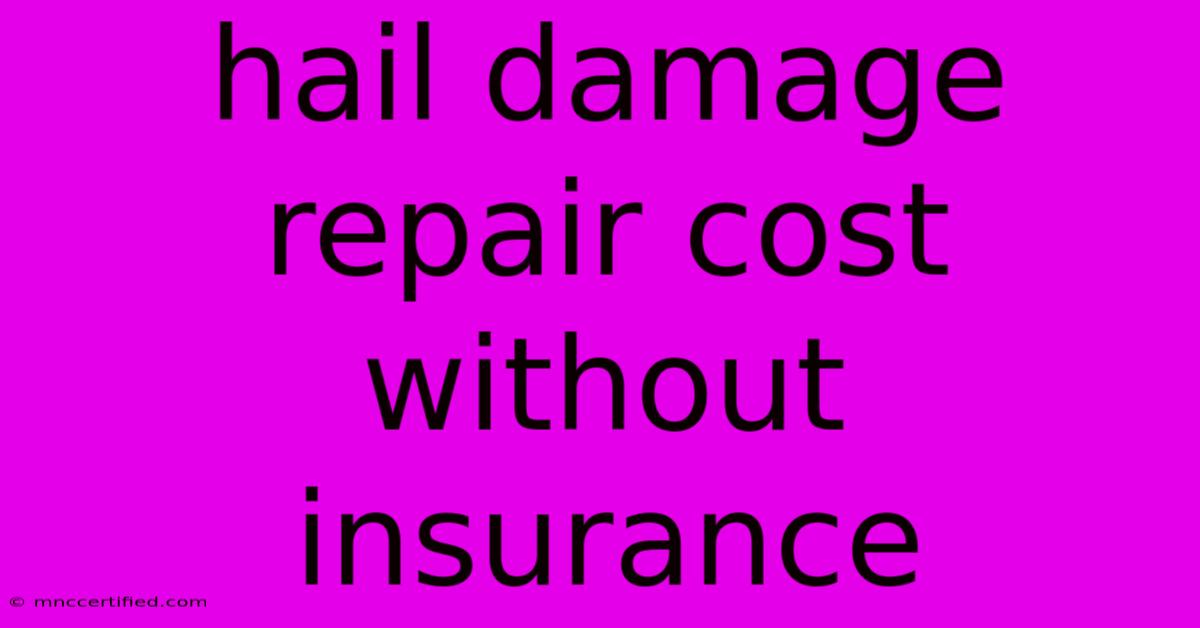Hail Damage Repair Cost Without Insurance

Table of Contents
Hail Damage Repair Cost Without Insurance: A Guide to Understanding the Expenses
Hailstorms can wreak havoc on your property, leaving behind a trail of dents, cracks, and other damage. If you're unfortunate enough to experience a hail storm without insurance coverage, the repair costs can be daunting. This article will guide you through the process of assessing and understanding the costs associated with hail damage repair without insurance.
Factors Affecting Hail Damage Repair Cost
The cost of repairing hail damage without insurance varies greatly depending on several factors. Here are some key considerations:
1. Extent of Damage:
- Minor Damage: Small dents and scratches might be manageable with paintless dent repair (PDR) techniques, resulting in lower costs.
- Significant Damage: Extensive dents, cracked panels, shattered windows, or roof damage will require more extensive repairs, leading to higher expenses.
2. Vehicle Type:
- Luxury or High-End Vehicles: These vehicles often have specialized parts and labor requirements, leading to higher repair costs.
- Standard Vehicles: Repairing damage to standard vehicles typically involves more readily available parts and labor, leading to lower overall costs.
3. Repair Method:
- PDR: Paintless dent repair is a cost-effective option for minor dents, but it may not be suitable for all types of damage.
- Traditional Bodywork: This method involves sanding, filling, and repainting, which can be more expensive than PDR, but is necessary for more severe damage.
4. Labor Costs:
- Location: Labor rates can vary significantly depending on your geographic location. Urban areas typically have higher labor costs compared to rural areas.
- Skill Level: Specialized repair techniques and experienced technicians often come with higher labor costs.
5. Parts Costs:
- OEM Parts: Original equipment manufacturer (OEM) parts are often the most expensive but offer the best quality and fit.
- Aftermarket Parts: These are cheaper alternatives, but may not be as durable or match the original quality.
Estimating Repair Costs
- Visual Inspection: A thorough visual inspection can help you assess the extent of damage and identify potential areas for repair.
- Professional Estimates: Consult with multiple reputable body shops for accurate estimates. Remember to inquire about the type of parts (OEM or aftermarket) used in their estimates.
- Online Tools: Some online tools can provide initial estimates based on your vehicle type, location, and damage description. However, these estimates may not be entirely accurate.
Alternative Options to Consider
- DIY Repair: Minor dents and scratches might be repairable with DIY techniques, but be cautious about the quality of repairs and potential for further damage.
- Secondhand Parts: Consider using used parts, especially if the damage is minor and the vehicle is not a luxury model.
- Negotiation: Once you have obtained multiple estimates, you can negotiate with body shops to get a more favorable price.
Managing the Financial Burden
- Savings: Set aside funds for potential repairs to avoid financial stress in case of a hailstorm.
- Credit Card: If you have a good credit score, using a credit card to finance the repairs could be a temporary solution.
- Payment Plans: Discuss with the repair shop about flexible payment options to make the cost more manageable.
Prevention is Key
- Carport or Garage: Parking your vehicle in a covered space can significantly reduce the risk of hail damage.
- Hail Protection: Some insurers offer optional hail damage protection for an additional premium.
Remember, the key to avoiding unexpected financial burdens is to be prepared. Understanding the factors affecting repair costs, obtaining multiple estimates, and considering alternative options will help you manage hail damage expenses without insurance effectively.

Thank you for visiting our website wich cover about Hail Damage Repair Cost Without Insurance. We hope the information provided has been useful to you. Feel free to contact us if you have any questions or need further assistance. See you next time and dont miss to bookmark.
Featured Posts
-
Bloomington Votes To Keep Ranked Choice Voting
Nov 07, 2024
-
What Insurance Does Mint Dentistry Accept
Nov 07, 2024
-
Insurance Check With Mortgage Company Name
Nov 07, 2024
-
Dogecoin Memecoins Surge As Trump Wins Us
Nov 07, 2024
-
Starmer Stands By Foreign Secretarys Trump Assessment
Nov 07, 2024